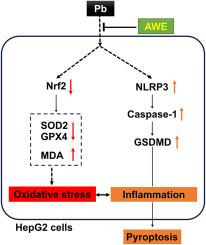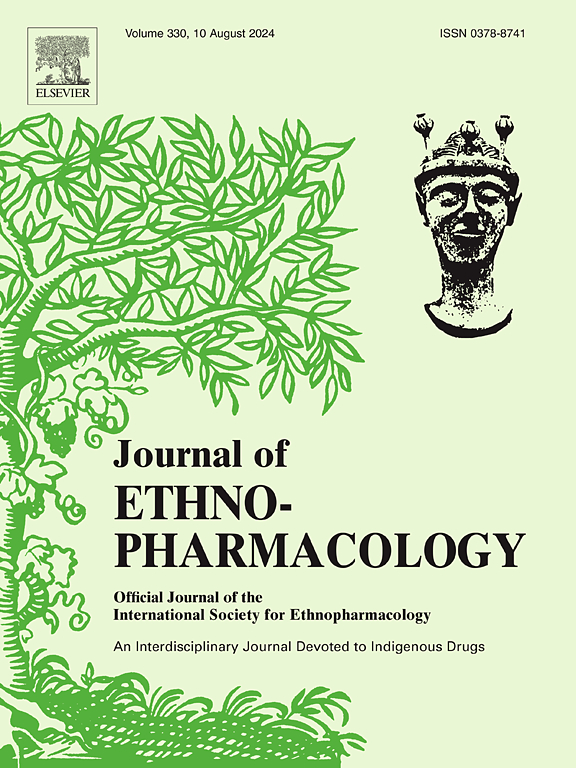Artichoke water extract protects against Lead-induced hepatotoxicity by activating Nrf2 signaling and inhibiting NLRP3/caspase-1/GSDMD-mediated pyroptosis
IF 5.4
2区 医学
Q1 CHEMISTRY, MEDICINAL
引用次数: 0
Abstract
Ethnopharmacological relevance
Lead (Pb), a predominant heavy metal in the environment, causes significant harm to mammalian organs by activating oxidative stress and inflammation. Artichoke (Cynarascolymus L.) is a conventional edible botanical remedy known for its diverse pharmacological attributes, including antioxidant and anti-inflammatory properties.
Aim
In this study, we aimed to investigate the effects of artichoke water extract (AWE) on Pb-induced liver toxicity and the potential underlying mechanisms.
Materials and methods
We identified and quantified the chemical compounds in AWE using ultra-performance liquid chromatography-tandem mass spectrometry (UPLC-MS/MS). Fifty male C57BL/6J mice (8-week-old) were randomly divided into five groups with ad libitum access to a standard diet and water. Over six weeks of experiments, the control group was orally administered 100 μL/day of distilled water. The Pb group received orally a Pb solution at 25 mg/kg body weight (BW)/day. The Pb + AWE (0.8) group received a combination of Pb solution (25 mg/kg BW) and AWE (0.8 g/kg BW) daily. Next, the Pb + AWE (1.6) group received a combination of Pb solution (25 mg/kg BW) and AWE (1.6 g/kg BW) daily. The Pb + vitamin C group received a combination of Pb solution (25 mg/kg BW) and vitamin C (50 mg/kg BW) daily. We evaluated tissue Pb levels, serum biochemical indices, liver function parameters, and histopathology post-experiment. HepG2 cells were cultured to investigate AWE's role and underlying mechanism of action on Pb-induced pyroptosis.
Results
Ninety-six major compounds were identified and quantified in AWE using UPLC-MS/MS. Treatment with AWE at 0.8 and 1.6 g/kg body weight (BW) significantly reduced tissue Pb accumulation, induced fecal Pb excretion, improved lipid profiles, and attenuated liver injury. In addition, AWE treatment increased superoxide dismutase (SOD) and glutathione peroxidase (GPx) activity and decreased malondialdehyde (MDA), 8-OHdG production, tumor necrosis factor-alpha (TNF-alpha), interleukin (IL)-6, and IL-1 beta expression in Pb-exposed mice and HepG2 cells. Mechanistically, the in vivo and in vitro results showed that AWE's antioxidant role was related to the activation of nuclear factor-E2-related factor 2 (Nrf2) signaling. Its anti-inflammatory effect was associated with the inhibition of Pb-induced pyroptosis by inhibiting the nucleotide-binding oligomerization domain-like receptor pyrin domain-containing protein 3 (NLRP3)/caspase-1/gasdermin D (GSDMD) pathway.
Conclusion
These findings indicate that AWE protects against Pb-induced liver toxicity potentially through its chelating, antioxidant, and anti-inflammatory properties.

洋蓟水提取物通过激活Nrf2信号和抑制NLRP3/caspase-1/ gsdmd介导的肝凋亡来预防铅诱导的肝毒性。
民族药理学相关性:铅(Pb)是环境中的主要重金属,通过激活氧化应激和炎症对哺乳动物器官造成重大伤害。洋蓟(Cynarascolymus L.)是一种传统的可食用植物药物,以其多种药理特性而闻名,包括抗氧化和抗炎特性。目的:研究洋蓟水提取物(AWE)对铅诱导的大鼠肝毒性的影响及其可能的机制。材料和方法:采用超高效液相色谱-串联质谱(UPLC-MS/MS)对AWE中的化合物进行鉴定和定量。选取8周龄雄性C57BL/6J小鼠50只,随机分为5组,给予标准饮食和水。在6周的实验中,对照组小鼠口服蒸馏水100 μL/d。铅组大鼠口服25 mg/kg体重/天的铅溶液。Pb + AWE(0.8)组每日给予Pb溶液(25 mg/kg BW)和AWE (0.8 g/kg BW)的组合。接下来,Pb + AWE(1.6)组每天给予Pb溶液(25 mg/kg BW)和AWE (1.6 g/kg BW)的组合。Pb +维生素C组每日给予Pb溶液(25 mg/kg BW)和维生素C (50 mg/kg BW)的组合。我们评估了组织铅水平、血清生化指标、肝功能参数和实验后的组织病理学。通过培养HepG2细胞,探讨AWE在pb诱导的HepG2细胞焦亡中的作用及其作用机制。结果:通过UPLC-MS/MS对AWE中96个主要化合物进行了鉴定和定量。以0.8 g/kg体重(BW)和1.6 g/kg体重(BW)给药可显著降低组织铅积累,诱导粪便铅排泄,改善脂质分布,减轻肝损伤。此外,AWE处理增加了铅暴露小鼠和HepG2细胞的超氧化物歧化酶(SOD)和谷胱甘肽过氧化物酶(GPx)活性,降低了丙二醛(MDA)、8-OHdG的产生、肿瘤坏死因子α (tnf - α)、白细胞介素(IL)-6和IL-1 β的表达。机制上,体内和体外实验结果表明,AWE的抗氧化作用与激活核因子e2相关因子2 (Nrf2)信号通路有关。其抗炎作用与通过抑制核苷酸结合寡聚化结构域样受体pyrin结构域-containing protein 3 (NLRP3)/caspase-1/gasdermin D (GSDMD)通路抑制pb诱导的焦亡有关。结论:这些发现表明,AWE可能通过其螯合、抗氧化和抗炎特性保护铅诱导的肝毒性。
本文章由计算机程序翻译,如有差异,请以英文原文为准。
求助全文
约1分钟内获得全文
求助全文
来源期刊

Journal of ethnopharmacology
医学-全科医学与补充医学
CiteScore
10.30
自引率
5.60%
发文量
967
审稿时长
77 days
期刊介绍:
The Journal of Ethnopharmacology is dedicated to the exchange of information and understandings about people''s use of plants, fungi, animals, microorganisms and minerals and their biological and pharmacological effects based on the principles established through international conventions. Early people confronted with illness and disease, discovered a wealth of useful therapeutic agents in the plant and animal kingdoms. The empirical knowledge of these medicinal substances and their toxic potential was passed on by oral tradition and sometimes recorded in herbals and other texts on materia medica. Many valuable drugs of today (e.g., atropine, ephedrine, tubocurarine, digoxin, reserpine) came into use through the study of indigenous remedies. Chemists continue to use plant-derived drugs (e.g., morphine, taxol, physostigmine, quinidine, emetine) as prototypes in their attempts to develop more effective and less toxic medicinals.
 求助内容:
求助内容: 应助结果提醒方式:
应助结果提醒方式:


